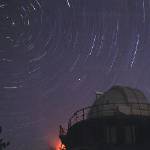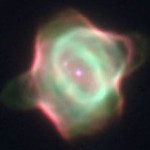|
A-level (ages 16-18) Physics has an Astrophysics or Cosmology option. You should already have a copy of your syllabus. If not, ask your teacher. A syllabus cannot teach you, however, so here I have gathered links to resources that I found invaluable when teaching Cosmology to sixth formers.
The links below are intended to offer additional guidance whilst you are studying the course, or afterwards for revision purposes:
Models of the Known Universe
 You should study: You should study:
- The work and models of Copernicus, Kepler and Galileo. [ link ]
- Applying Newton's Universal Law of Gravitation to derive Kepler's Third Law. [ link ]
- Predicting the existence of the Outer Planets from perturbations. [ link ]
- The contents of the Solar System. [ link ]
- The definitions of the astronomical unit (AU), parsec (pc) and light year (ly).
Click here for some questions on these topics!
Stars and Galaxies
 This is a very large topic, but you should know about: [ General Link ] This is a very large topic, but you should know about: [ General Link ]
- the magnitude (brightness) scales of stars + galaxies [ link ]
- the temperature of stars, and how they can be determined. [ link ]
- how stars evolve over time. [ link ]
- the different structure of galaxies. [ link ]
The Evolving Universe
 You should know: You should know:
- about line spectra (emission + absorption) [link]
- Doppler shift [ link | link ]
- Hubble's law [ link ]
- Olbers' "paradox". [ link | link ]
- the Colsmological Principle [ link ]
- how the age of the Universe can be determined. [ link ]
- how the Universe evolved from the Big Bang to the present
Top Right ^^
|
Observational Techniques
 You should know that:
You should know that:
- stars and galaxies emit a wide range of electromagnetic (EM) radiation, whereas planets merely reflect light from the Sun.
- only certain types of EM radiation make it through the Earth's atmosphere. [ link ]
- improved observation of radiation can be obtained by positioning telescopes on top of mountains, or in orbit. [ link ]
- cutting-edge astronomical research is expensive, and could perhaps be better spent.
Special Relativity
 You should know: [ General Link ]
You should know: [ General Link ]
- why the concept of the ether was put forward to explain the propagation of EM waves. [ link ]
- the principles of the Michelson Morley experiment, and why its null result is so important. [ link ]
- Einstein's two postulates of Special Relativity.[ link | link ]
- how to descirbe thought experiments of time dilation and length contraction. [ link | link ]
- why the observed half life of atmospheric muons agrees with time dilation. [ link ]
- understand the equation E = mc², and be able to apply it to explain why there is a maximum attainable speed, c, for a body with mass. [ link ]
Navigate:

View/Sign Guestbook | Recommend Site!
There is also a GCSE version of this page.
Last updated Sunday 1st June 2003
|


 You should study:
You should study:
 This is a very large topic, but you should know about: [ General Link ]
This is a very large topic, but you should know about: [ General Link ]
 You should know:
You should know:
 You should know that:
You should know that:
 You should know: [ General Link ]
You should know: [ General Link ]